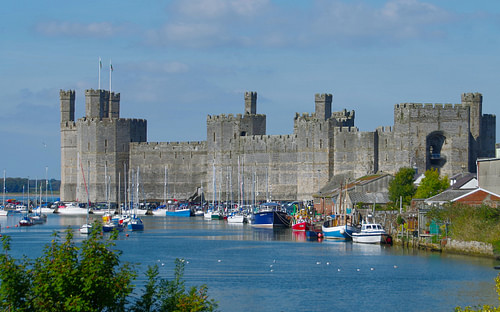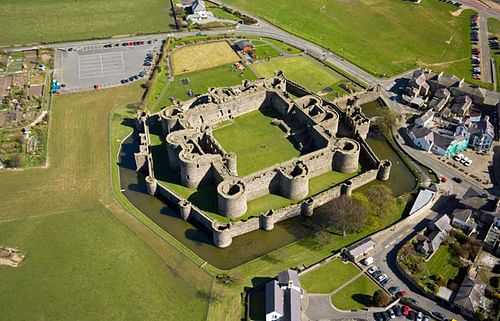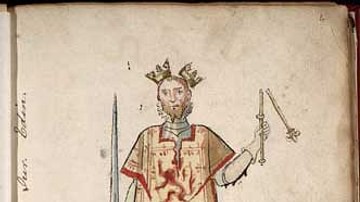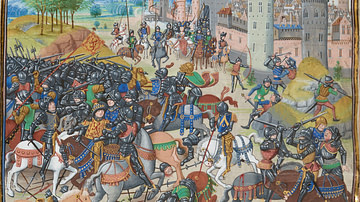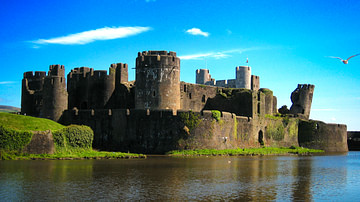
Edward I of England reigned as king from 1272 to 1307 CE. Edward succeeded his father Henry III of England (r. 1216-1272 CE) and was known as 'Longshanks' for his impressive height and as 'the Hammer of the Scots' for his repeated attacks on Scotland. In an eventful and often brutal reign, he fought in a crusade, subdued Wales, had a good go at conquering Scotland, and built many fine castles which still survive today, particularly in North Wales. He was succeeded by his son Edward II of England (r. 1307-1327 CE) and then his grandson Edward III of England (r. 1327-1377 CE).
Second Baron's War & Succession
Prince Edward was born on 17 or 18 June 1239 CE, the eldest son of Henry III of England and Eleanor of Provence (1223-1291 CE). Known for his fiery temper and self-confidence, Edward was nicknamed 'Longshanks' because of his height – 1.9 metres (6 ft. 2 inches), an unusually impressive stature for medieval times. He was strong, athletic, and as good a horseman as he was a swordsman. Edward was a staunch supporter of the medieval tournament, an event he often took part in personally, once famously unseating the Count of Chalon in a tournament held in Chalon. Destined to be king, the young prince would still have to battle hard to ensure his father's and his own throne remained secure from usurpers.
Henry III had successfully put an end to the Barons' War which had been fuelled by discontent over his father King John of England's rule (r. 1199-1216 CE) and his failure to honour the Magna Carta charter of liberties. Henry and his regent Sir William Marshal, Earl of Pembroke (c. 1146-1219 CE), considered the greatest of all medieval knights, defeated the rebel barons in battle at Lincoln on 20 May 1217 CE. Unfortunately, Henry did not grasp the lesson and his ineffective military campaigns, high taxes to pay for them, and excessive patronage of his French relatives only resulted in a second Barons' War.
The barons wanted a limit on royal power and stipulated in the 1258 CE Provisions of Oxford that taxes should go to the Treasury and not be available for the king's whims, and that a ruling council of 15 barons should advise the king. Another body, a parlement, was established as a place for discussion of policy to which knights of the counties and burgesses of certain boroughs were invited to participate. Henry repudiated the Provisions in 1262 CE and so a civil war broke out.
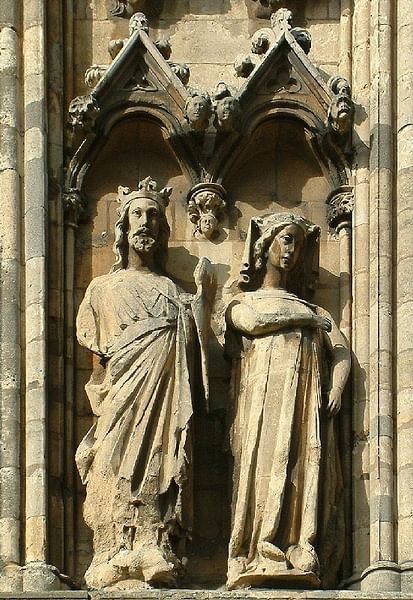
Things did not go well for the royalists. On 14 May 1264 CE, after the Battle of Lewes, the king and Prince Edward were both captured by the rebel leader Simon de Montfort, Earl of Leicester (l. c. 1208-1265 CE) who then made himself king in 1264 CE. Fortunately for Henry, his son Edward managed to escape confinement in May 1265 CE and so could help restore the rightful monarch to the throne.
Edward, who had already gained valuable military experience from his father's campaigns in Wales, raised an army of loyalists and those barons already upset by de Montfort's self-seeking policies and defeated the rebels at the Battle of Evesham in Worcestershire on 4 August 1265 CE. De Montfort was killed, and Henry was restored but spent much of his later years away from politics and improving the country's architectural monuments such as Westminster Abbey and Lincoln Cathedral.
Edward, in effect, acted as regent for his father and following Henry's death, probably from a stroke, on 16 November 1272 CE, Prince Edward became Edward I of England. As Edward was away on what is sometimes called the Ninth Crusade (1271-2 CE), the actual coronation did not take place until 19 August 1274 CE, as usual at Westminster Abbey. Edward would reign until 1307 CE.
Personal Life
Edward married Eleanor of Castile (b. c. 1242 CE) in October 1254 CE when she was 12 and he was just 15 years old but the match worked out well. Eleanor even accompanied her husband on his crusade and when she died in 1290 CE, Edward suffered her loss greatly. The passage of her coffin from Lincoln to London was commemorated by the setting up of 12 monumental crosses, and one of these, the last on the route, would give London's Charing Cross its name. Edward, already with a family of 11 daughters and four sons, did marry again, on 10 September 1299 CE, to Margaret (c. 1282-1318 CE), the daughter of Philip III of France (r. 1270-1285 CE). Margaret was more than 40 years younger than Edward, but the marriage was another success.
Subjugation of Wales
Henry III's string of military defeats in Wales (1228, 1231, and 1232 CE) had led to Henry conferring on Llywelyn ap Gruffudd (c. 1223-1282 CE) the title of Prince of Wales. The Welshman's independence was further asserted when he refused to attend Edward's coronation in 1274 CE. The new king was rather better at warfare than his father had been, though, and Edward was intent on taking revenge for the slight. Organising a massive army in 1276 CE, the English king marched into Wales and stripped Llywelyn of his lands, although he did permit him to keep his now-meaningless royal title. Nevertheless, the Welsh still had ambitions of freedom from English rule and Llywelyn's brother Dafydd stirred up yet another rebellion. The rebels were defeated and Llywelyn was killed in 1282 CE, his head presented to the English king in triumph and then displayed at the Tower of London. Dafydd was eventually captured, and he was executed, too, using the brutal method reserved for traitors: hanging, drawing, and quartering the victim.
Edward now became determined to thoroughly impose his domination of the region, particularly in North Wales where the rebels had had their headquarters, by building a series of mighty castles. From 1283 CE onwards such imposing fortresses as Caernarfon Castle, Conwy Castle, and Harlech Castle were built. The king made sure his castles were often built on sites of cultural and historical importance to the Welsh to send a clear message that a new order had begun in the region. He even went so far as to ensure his son Edward was born in Caernarfon Castle – the heart of the English administration in Wales – on 25 April 1284 CE and then bestowed upon him the title of Prince of Wales (formally conferred in 1301 CE). Thereafter, it became customary for an English monarch to give this title to their eldest son.
Despite the castles and the royal propaganda, the Welsh were not quite subdued and another major rebellion broke out, this time led by Madog ap Llywelyn, in 1294 CE. Edward, despite being forced to winter in Conwy Castle, managed to regain control of Caernarfon Castle by 1295 CE. Madog was then defeated by an army led by the Earl of Warwick at Maes Moydog in March 1295 CE, and Wales was henceforth administered as if it were a part of England, the region already having been divided up into shires in the 1284 CE Statute of Rhuddlan in order to break up the old traditional kingdoms. A new series of castles was then erected to ensure continued obedience, which included Beaumaris Castle, perhaps the finest surviving example of a concentric medieval castle.
Administration in England
Edward attempted to avoid the errors of his predecessors by ensuring his home base of England was secure. The king made sure that the barons and their rights were protected, and that local administration was improved through a land survey (1274-5 CE) and better record-keeping (the Hundred Rolls). The 1275 CE the Statute of Westminster encoded 51 new laws, many based on the Magna Carta. Trial by jury was made mandatory (previously the accused had to consent to it) and Justices of the Peace were appointed.
The Model Parliament met for the first time in 1295 CE which had members from the clergy and knights as well as large estate owners, including two representatives from every shire and town (or borough). Membership of the parliament was still only given to those with wealth, but it was wider than ever before as Edward sought the best possible means to secure support for his greater revenue demands. The parliament also approved Edward's proposed military campaign in Scotland. The king might not have had any interest in limiting his own power or increasing that of the elite but his regular calling of parliament for the purposes of raising taxes nevertheless did kickstart the body as an ever-present institution in English government which acquired a character and precedence of its own. The inclusion of wealthy but untitled members was the beginning of what would become the House of Commons.
Another consequence of the need for funds was the attack on the kingdom's Jewish community. In 1287 CE Edward happily began to expel all Jews from his kingdom, confiscating their property to boost his war coffers and appease the Church who regarded the moneylenders as a threat. By 1290 CE, the policy resulted in almost all 2,000 Jews in the kingdom leaving, one way or another, and Edward was so pleased with his policy that he repeated it in Gascony (see below).
Attacks on Scotland
Edward was not content with ruling England and Wales but also set his sights on Scotland. The English king had hoped to gain control of Scotland via peaceful means when he arranged for his son to marry Margaret, the Maid of Norway who was the granddaughter and heir of King Alexander III of Scotland (r. 1249-1286 CE). Unfortunately, these plans came to nothing when Margaret died of illness on Orkney in September 1290 CE. Edward was then required to adjudicate who would be Alexander's successor (an event often termed the Great Cause): the powerful nobleman John Balliol (b. c. 1249 CE) or Robert Bruce (b. 1210 CE and grandfather of his more famous namesake). In 1292 CE Edward plumbed for Balliol, perhaps because he was the weaker of the two and so could be more easily manipulated. As it turned out, the Scots themselves grew tired of Balliol's ineffective responses to Edward's domination and open rebellion was in the air.
The English king was just then having problems elsewhere. Wales was about to witness the Madog-led rebellion of 1294 CE and Gascony was under serious threat in France – the king's only territory across the Channel since his father had signed it all away in the 1259 CE Treaty of Paris. Gascony, which provided a nice income through taxation of the flourishing wine trade, was indeed lost to the ambitious Philip IV of France (r. 1285-1314 CE) and the taxes Edward had imposed on the Scots to pay for his failed campaign in France was the final straw. In 1295 CE Scotland formally allied itself with France – the first move in what became known as the 'Auld Alliance' – and Balliol felt confident enough not to pay homage to Edward.
The English king responded emphatically to Scottish disobedience by forming a new army which he led in person to Berwick, the force totalling 25,000-30,000 men. At Berwick, according to the 14th-century CE chronicler Walter of Guisborough, Edward started as he meant to continue and massacred 11,060 of the town's residents. The king, earning the nickname 'the Hammer of the Scots', was now intent on total conquest, and by June he had gone a long way to achieving his goal. Balliol surrendered after the Battle of Dunbar (1296 CE), three English barons were nominated to rule Scotland and Edward even stole the Stone of Scone (aka Stone of Destiny) which was a symbol of the Scottish monarchy, relocating it to Westminster Abbey under the coronation chair. The stone was only returned in 1996 CE. There was, too, good news from France where Gascony was returned to Edward following the Pope's intervention in the dispute. The friendly relations were cemented by Edward's marriage to Philip III's daughter Margaret and the Prince of Wales' betrothal to Isabella, daughter of Philip IV of France.
Scotland was never quite subdued, though, and despite invasions in 1298 and 1300 CE, a major rebellion broke out led by the landowner (and later knight) William Wallace (c. 1270-1305 CE) – eponymous star of the 1995 CE film Braveheart – and Sir Andrew Moray of Bothwell. The rebels won a famous victory in September 1297 CE at the Battle of Stirling Bridge but Edward, leading his army in person, won another encounter in July 1298 CE at the Battle of Falkirk where 20,000 Scots were killed. Edward then sent more armies in 1301 and 1303 CE, recovering Stirling Castle in the process, but it was not until 1305 CE that Wallace was finally captured in Glasgow and then executed as a traitor in London. Still, in February 1306 CE, the Scots continued to rally around their figurehead, Robert the Bruce (b. 1274 CE), the grandson of John Balliol's rival for the throne back in 1292 CE. Making himself king in February 1306 CE, Robert had the support of the Scottish northern barons but was initially forced to flee to Ireland. However, both he and the Scots benefitted greatly from Edward's sudden death and the incompetence of his successor; King Robert would rule Scotland until 1329 CE. 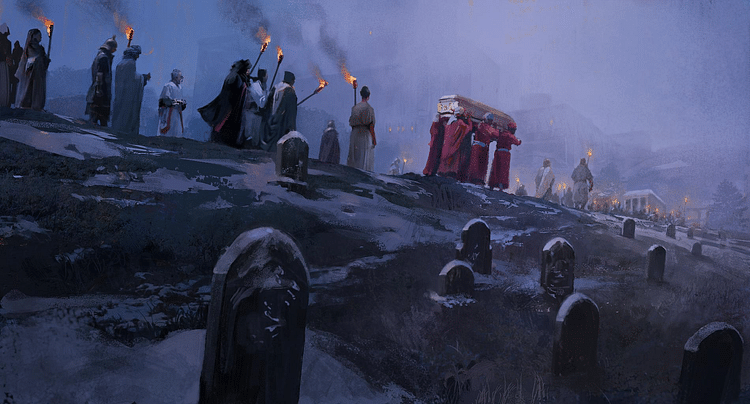
Death & Successor
Edward died of illness, probably dysentery, aged 68 on 7 July 1307 CE at Burgh by Sands, near Carlisle when about to engage in yet another campaign against the Scots. He was buried at Westminster Abbey and, at his own command, his tomb was inscribed with the following legend: 'Edward I, Hammer of the Scots. Keep the Faith'. He was succeeded by his son Edward II of England whose reign until 1327 CE was blighted by military incompetence, excessive patronage of his friends, anarchy at home amongst his own barons and, the cherry on a far-from-splendid royal cake, a resounding defeat by the Scots at Bannockburn in June 1314 CE. Another Edward would succeed him, Edward III of England, the grandson of Edward I and final part of the trio that completed the 'Edwardian' period of medieval England (1272-1377 CE).
